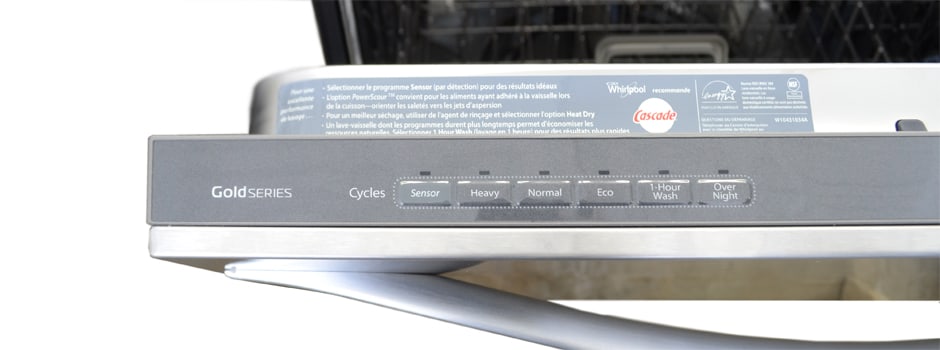Pros
Cons
Introduction
The Whirlpool WDT910SAYM is that guy. With a stainless steel front, prominently-displayed buttons, and a standard selection of cycles and added features, there's nothing too fancy or gimmicky. Just load Bob up (Seriously, have you even asked him his name?) tell him what to do, and he'll quietly get to work.
Like Bob, part of the WDT910SAYM's appeal is that it'll work diligently, even if it isn't particularly ambitious. With an $849 MSRP and even lower sale prices, its salary demands are also quite reasonable. Even better, it's very efficient.
Design & Usability
{{section_header}}{{ section.name }}{{/section_header}}
We weren't expecting to be wowed, but we weren't expecting disappointment, either.
Like Bob, with his button-down shirt and microfiber pants, the WDT910SAYM won't make it on the cover of a fashion machine but it sure blends in with its environment. The no-nonsense, monolithic, stainless steel front looks modern, and the top-mounted controls are easy to read and give a satisfying click when pressed. Soft blue lights will tell you which cycle and options you’ve selected. Whirlpool’s design team appeared to have aimed at simplicity and usability, and they definitely accomplished it. There’s nothing innovative, but nothing’s missing, either.
Open the door and you’re greeted by a stainless steel interior, which helps speed up drying time and reduce noise. The two racks slide out without any noticeable resistance, and dutifully stay on their tracks. The whole assembly is sturdy and stable. While the top rack has two collapsible rows of tines, the bottom rack only offers a halfhearted attempt at flexibility—one row of tines can (with a little bit of force) be shifted to widen that row and make some more space. Unfortunately, we’ve found that the extra room doesn’t even allow us to fit the standard serving dishes we use in our tests.
The cutlery basket is of a standard Whirlpool design that can be found in other Gold Series dishwashers. It’s a simple plastic holder to keep your utensils spaced out, and the two top covers and the entire front can all be opened. It has a handle in the middle that cannot be adjusted in any way. This can be a nuisance when loading or unloading, and definitely takes up more space than it needs to. Additionally, the basket can only be placed along the very front or the very back of the bottom rack. We’ve found that the back row is the only area with space for our serving dishes, which means that the front is the only logical place to put the basket.
{{photo_gallery "Design Gallery"}}
Features
{{section_header}}{{ section.name }}{{/section_header}}
The WDT910SAYM has a wide range of options to address all of your dishwashing needs.
The WDT910SAYM offers a wide range of dishwashing options. In addition to the three standard cycles (1-Hour Wash, Normal, Heavy), there are the options of Eco, Overnight, and Sensor cycles. The Sensor cycle uses the WDT910SAYM’s internal sensors to determine the right amount of water and energy to use. It’s basically a good choice for when you don’t know just how dirty your dishes are. On top of the choice of wash cycles, there are also options to increase the washing temperature, activate the high-intensity spray jets, and add a sanitizing rinse. A heat-dry option, 4-hour start delay, and child lock round out the WDT910SAYM’s inventory of features.
Performance
{{section_header}}{{ section.name }}{{/section_header}}
Scrape your dishes first, and you shouldn't have any problems.
Despite the outward appearance of competence and the attractive array of wash options, the WDT910SAYM had a little trouble with something we in the dishwashing biz call "redeposit." That's when a dishwasher takes all the food it's washed off and sprays it all over clean dishes. It's particularly a problem with dishwashers that don't use enough water to flush out errant food particles, which was likely the case here: the WDT910SAYM had one of the lowest operating costs we've seen.
While this Whirlpool had no trouble cleaning off bigger chunks of food, it redeposited smaller stains like puréed spinach. In fact, there was spinach everywhere, enough to sandbag what would've otherwise been a near-perfect performance. We recommend you scrape your dishes before putting them in the washer.
Conclusion
{{section_header}}{{ section.name }}{{/section_header}}
Not a standout employee, but certainly no slacker.
In short, the WDT910SAYM doesn't stand out in any way. In an office, that might mean it gets a cubicle next to the bathroom, and it'll always get left out of the March Madness pool. But it'll never get fired, because it's a solid performer that's inexpensive to buy and cheap to run. Content with free pizza once a month and a discount commuter rail pass, it'll never ask for a raise. As long as you aren't demanding perfection, it's a decent addition to your kitchen.
Introduction
{{section_header}}{{ section.name }}{{/section_header}}
Like a quarterly performance review for our fictional underachieving office drone, here is the data showing just how the WDT910SAYM did on our tests. Unlike a quarterly performance review, we cannot re-train or terminate the WDT910SAYM. At least we know it won't be asking for a raise.
Performance
{{section_header}}{{ section.name }}{{/section_header}}
Redepositing soil onto other dishes is the main performance issue with the WDT910SAYM.
Across each of the three main cycles (Quick Wash, Normal, and Heavy), the WDT910SAYM consistently redeposited minced meat and spinach. It's nearly impossible for any dishwasher to ace this test entirely, but this one had particular trouble. It only got a good overall score because it had zero trouble cleaning off nearly every other stain. In fact, the only reason some of the other tests didn’t score 100% was because we found spinach particles stuck to them.
For the Heavy cycle, we add a handful of extra items to the mix, including a lasagna test. The WDT910SAYM was able to clean the serving dish we smeared the lasagna on, but the pasta chunks were left sitting in the dish. Granted, they weren’t stuck to the dish, but that can’t truly be considered clean. Considering that the Heavy cycle took well over 3 hours, we were expecting a little bit more.
{{photo_gallery "Performance Gallery"}}
Efficiency
{{section_header}}{{ section.name }}{{/section_header}}
The WDT910SAYM doesn't use much water for its Normal cycle, which may explain its issues with redeposit.
Perhaps the secret to the WDT910SAYM's issues with redeposit is that it doesn’t use enough water to flush out the waste food that's come off plates. If you scrape your plates, however, you should save a decent amount of money on your water bill.
The aptly-named Quick Wash, which lasts exactly one hour, used a little over 5 gallons of water and has an average cost of 10 cents per cycle. The Normal cycle only uses 2.88 gallons, but took 2.5 hours to complete. The extra electricity bumps the cost of each run to about 12 cents. Finally, the Heavy cycle used 7.83 gallons of water for over 3 hours, pushing the cost to 19 cents per run. This adds up to a yearly average cost of $28.04, assuming you use the Normal cycle 50 percent of the time. That's pretty good, and shows that the WDT910SAYM is an efficient machine.
{{photo_gallery "Efficiency Gallery"}}
Capacity
{{section_header}}{{ section.name }}{{/section_header}}
The WDT910SAYM is average everywhere else, but gets a perfect ten here.
The WDT910SAYM was able to fit the usual ten place settings and one serving setting. While there wasn’t enough room to squeeze in an 11th place setting, we did find that there was still a good amount of extra space in the top rack. This could be used to fit extra cups or glasses, or smaller dessert dishes. As a reminder on how we test capacity, one place setting equates to one dinner plate, bread plate, fruit bowl, glass, saucer, mug, dinner fork, knife, and two spoons. After every six place settings, we add a serving setting, which is one platter, serving bowl, fruit bowl, and four serving utensils. Ten place settings is the average score for most dishwashers of this size, and the WDT910SAYM is no exception.
{{photo_gallery "Capacity Gallery"}}
Meet the tester
Checking our work.
Our team is here to help you buy the best stuff and love what you own. Our writers, editors, and experts obsess over the products we cover to make sure you're confident and satisfied. Have a different opinion about something we recommend? Email us and we'll compare notes.
Shoot us an email

